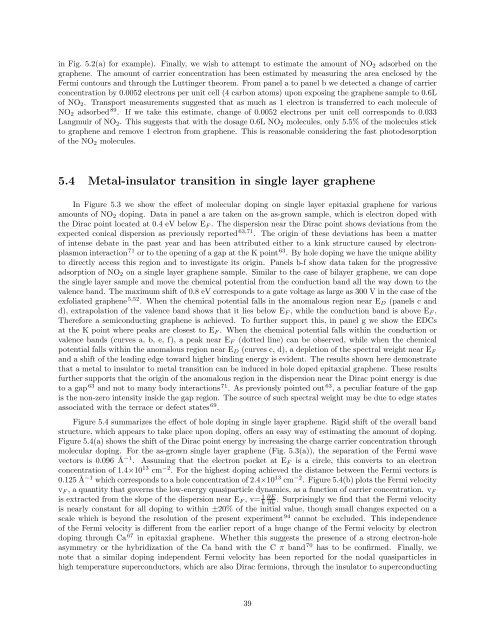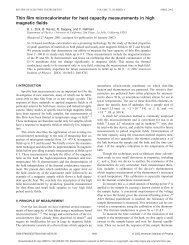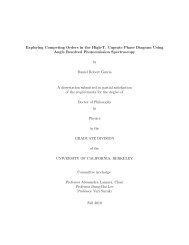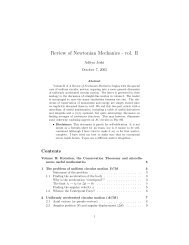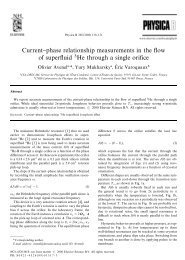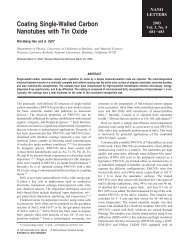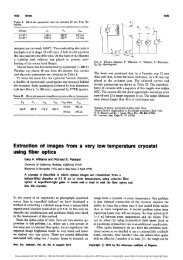Dirac Fermions in Graphene and Graphiteâa view from angle ...
Dirac Fermions in Graphene and Graphiteâa view from angle ...
Dirac Fermions in Graphene and Graphiteâa view from angle ...
Create successful ePaper yourself
Turn your PDF publications into a flip-book with our unique Google optimized e-Paper software.
<strong>in</strong> Fig. 5.2(a) for example). F<strong>in</strong>ally, we wish to attempt to estimate the amount of NO 2 adsorbed on the<br />
graphene. The amount of carrier concentration has been estimated by measur<strong>in</strong>g the area enclosed by the<br />
Fermi contours <strong>and</strong> through the Lutt<strong>in</strong>ger theorem. From panel a to panel b we detected a change of carrier<br />
concentration by 0.0052 electrons per unit cell (4 carbon atoms) upon expos<strong>in</strong>g the graphene sample to 0.6L<br />
of NO 2 . Transport measurements suggested that as much as 1 electron is transferred to each molecule of<br />
NO 2 adsorbed 89 . If we take this estimate, change of 0.0052 electrons per unit cell corresponds to 0.033<br />
Langmuir of NO 2 . This suggests that with the dosage 0.6L NO 2 molecules, only 5.5% of the molecules stick<br />
to graphene <strong>and</strong> remove 1 electron <strong>from</strong> graphene. This is reasonable consider<strong>in</strong>g the fast photodesorption<br />
of the NO 2 molecules.<br />
5.4 Metal-<strong>in</strong>sulator transition <strong>in</strong> s<strong>in</strong>gle layer graphene<br />
In Figure 5.3 we show the effect of molecular dop<strong>in</strong>g on s<strong>in</strong>gle layer epitaxial graphene for various<br />
amounts of NO 2 dop<strong>in</strong>g. Data <strong>in</strong> panel a are taken on the as-grown sample, which is electron doped with<br />
the <strong>Dirac</strong> po<strong>in</strong>t located at 0.4 eV below E F . The dispersion near the <strong>Dirac</strong> po<strong>in</strong>t shows deviations <strong>from</strong> the<br />
expected conical dispersion as previously reported 63,71 . The orig<strong>in</strong> of these deviations has been a matter<br />
of <strong>in</strong>tense debate <strong>in</strong> the past year <strong>and</strong> has been attributed either to a k<strong>in</strong>k structure caused by electronplasmon<br />
<strong>in</strong>teraction 71 or to the open<strong>in</strong>g of a gap at the K po<strong>in</strong>t 63 . By hole dop<strong>in</strong>g we have the unique ability<br />
to directly access this region <strong>and</strong> to <strong>in</strong>vestigate its orig<strong>in</strong>. Panels b-f show data taken for the progressive<br />
adsorption of NO 2 on a s<strong>in</strong>gle layer graphene sample. Similar to the case of bilayer graphene, we can dope<br />
the s<strong>in</strong>gle layer sample <strong>and</strong> move the chemical potential <strong>from</strong> the conduction b<strong>and</strong> all the way down to the<br />
valence b<strong>and</strong>. The maximum shift of 0.8 eV corresponds to a gate voltage as large as 300 V <strong>in</strong> the case of the<br />
exfoliated graphene 5,52 . When the chemical potential falls <strong>in</strong> the anomalous region near E D (panels c <strong>and</strong><br />
d), extrapolation of the valence b<strong>and</strong> shows that it lies below E F , while the conduction b<strong>and</strong> is above E F .<br />
Therefore a semiconduct<strong>in</strong>g graphene is achieved. To further support this, <strong>in</strong> panel g we show the EDCs<br />
at the K po<strong>in</strong>t where peaks are closest to E F . When the chemical potential falls with<strong>in</strong> the conduction or<br />
valence b<strong>and</strong>s (curves a, b, e, f), a peak near E F (dotted l<strong>in</strong>e) can be observed, while when the chemical<br />
potential falls with<strong>in</strong> the anomalous region near E D (curves c, d), a depletion of the spectral weight near E F<br />
<strong>and</strong> a shift of the lead<strong>in</strong>g edge toward higher b<strong>in</strong>d<strong>in</strong>g energy is evident. The results shown here demonstrate<br />
that a metal to <strong>in</strong>sulator to metal transition can be <strong>in</strong>duced <strong>in</strong> hole doped epitaxial graphene. These results<br />
further supports that the orig<strong>in</strong> of the anomalous region <strong>in</strong> the dispersion near the <strong>Dirac</strong> po<strong>in</strong>t energy is due<br />
to a gap 63 <strong>and</strong> not to many body <strong>in</strong>teractions 71 . As previously po<strong>in</strong>ted out 63 , a peculiar feature of the gap<br />
is the non-zero <strong>in</strong>tensity <strong>in</strong>side the gap region. The source of such spectral weight may be due to edge states<br />
associated with the terrace or defect states 69 .<br />
Figure 5.4 summarizes the effect of hole dop<strong>in</strong>g <strong>in</strong> s<strong>in</strong>gle layer graphene. Rigid shift of the overall b<strong>and</strong><br />
structure, which appears to take place upon dop<strong>in</strong>g, offers an easy way of estimat<strong>in</strong>g the amount of dop<strong>in</strong>g.<br />
Figure 5.4(a) shows the shift of the <strong>Dirac</strong> po<strong>in</strong>t energy by <strong>in</strong>creas<strong>in</strong>g the charge carrier concentration through<br />
molecular dop<strong>in</strong>g. For the as-grown s<strong>in</strong>gle layer graphene (Fig. 5.3(a)), the separation of the Fermi wave<br />
vectors is 0.096 Å −1 . Assum<strong>in</strong>g that the electron pocket at E F is a circle, this converts to an electron<br />
concentration of 1.4×10 13 cm −2 . For the highest dop<strong>in</strong>g achieved the distance between the Fermi vectors is<br />
0.125 Å −1 which corresponds to a hole concentration of 2.4×10 13 cm −2 . Figure 5.4(b) plots the Fermi velocity<br />
v F , a quantity that governs the low-energy quasiparticle dynamics, as a function of carrier concentration. v F<br />
is extracted <strong>from</strong> the slope of the dispersion near E F , v= 1 <br />
. Surpris<strong>in</strong>gly we f<strong>in</strong>d that the Fermi velocity<br />
is nearly constant for all dop<strong>in</strong>g to with<strong>in</strong> ±20% of the <strong>in</strong>itial value, though small changes expected on a<br />
scale which is beyond the resolution of the present experiment 94 cannot be excluded. This <strong>in</strong>dependence<br />
of the Fermi velocity is different <strong>from</strong> the earlier report of a huge change of the Fermi velocity by electron<br />
dop<strong>in</strong>g through Ca 67 <strong>in</strong> epitaxial graphene. Whether this suggests the presence of a strong electron-hole<br />
asymmetry or the hybridization of the Ca b<strong>and</strong> with the C π b<strong>and</strong> 70 has to be confirmed. F<strong>in</strong>ally, we<br />
note that a similar dop<strong>in</strong>g <strong>in</strong>dependent Fermi velocity has been reported for the nodal quasiparticles <strong>in</strong><br />
high temperature superconductors, which are also <strong>Dirac</strong> fermions, through the <strong>in</strong>sulator to superconduct<strong>in</strong>g<br />
∂E<br />
∂k<br />
39


